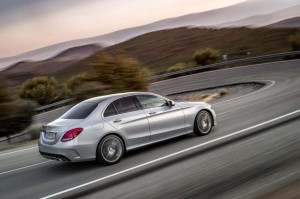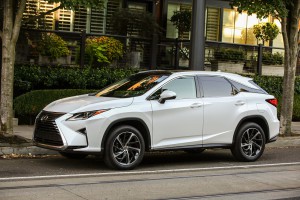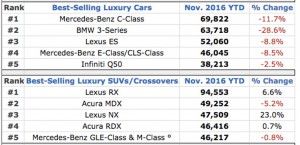
Mercedes' C-Class sedan was the top selling luxury sedan in the U.S. this year, and Mercedes was the top selling luxury brand.
Barring an unforeseen December setback, Mercedes-Benz will top the U.S. luxury market this year. And its C-Class will top the sedan sales chart, as well.
But that’s not the victory it might seem, at least when it comes to the C-Class. So far this year, SUVs, not sedans, have been dominating the American vehicle luxury market, the Lexus RX outselling the Mercedes C-Class by about 35%.
“Low gas prices, changing consumer tastes and attractive new vehicles are creating the perfect environment for luxury SUV sales to grow,” said Jessica Caldwell, executive director of industry analysis for research firm Edmunds. “Given that luxury brand loyalty rates are typically higher than for volume brands, this trend has the potential to affect this vehicle segment for years to come.”
Sedans long dominated the luxury vehicle market, with only a handful of classic SUVs and newer crossover-utility vehicles available for high-line buyers. But luxury utes are suddenly flooding the market and finding a receptive audience at every level, from entry-lux models like the Mercedes GLA all the way up to the new Bentley Bentayga. In fact, virtually every ultra-premium brand, including such names as Rolls-Royce and Aston Martin, is not working up a new ute offering.
(Mercedes set to lock down U.S., global luxury sales title. Click Here for the story.)
At Porsche, the big Cayenne was a real game-changer, the ute now the brand’s top-seller, with the smaller Macan rapidly gaining momentum.

Mercedes may have been the best selling luxury brand in the U.S. this year, it was the Lexus RX that was the top selling vehicle.
And British marque Jaguar, after years of struggle, has posted its biggest upturn in decades, thanks to strong demand for the all-new F-Pace crossover. Demand for that CUV has far exceeded that of other new Jaguar models, including the new XE sedan sharing the ute’s basic underpinnings.
Volvo has seen similar explosive growth with the all-new XC90, the ute scoring a number of high-profile kudos, including being named North American Truck/Utility Vehicle of the year last January by a jury of 60 U.S. and Canadian auto journalists.
A look at the U.S. luxury sales charts is quite telling. The number one sedan for the first 11 months of the year was the Mercedes C-Class. American buyers snapped up 69,822 of the sedans, according to industry data, a year-over-year decline of 11.7%.
In fact, all of the top five sedans suffered declining sales through the end of November, including the 28.6% dip for the second model on the chart, the BMW 3-Series.
(Click Here for details about Rolls-Royce offering a good look at its new SUV.)
By comparison, the top-selling ute, the Lexus RX, recorded a 6.6% increase through the end of November, with sales of 94,553. Demand rose for three of the top five utility vehicles, only the Acura MDX and Mercedes-Benz GLE losing momentum.
According to Edmunds, the shift from sedans, coupes and wagons to SUVs and CUVs is “largely being led by women.” A full 57% of the women who bought a luxury vehicle so far this year have opted for utility models. The numbers were almost evenly split for men. They chose utes 49% of the time.
And women are having a broader impact on the luxury market, in general, according to Caldwell. They accounted for 40% of the high-line vehicles sold during the first 11 months of 2016, up from 36% in 2011.
While some manufacturers – such as Jaguar – were late to the SUV party, they’re quickly benefiting from this massive shift as they join the fray. Even those makers who were early entrants are racing to expand their SUV line-up. Cadillac – which scored with the original Escalade – is working up as many as three new crossover models by 2020.
And those with fat wallets will soon have plenty to choose from. The Bentley Bentayga will soon be joined by offerings from Rolls-Royce, Aston Martin and Lamborghini, as well as the Maserati Levante that also went on sale this year.
(U.S. auto sales rebound in November. For more, Click Here.)
“Luxury automakers who anticipated this trend are really reaping the rewards: they’re attracting previously untapped buyers, increasing brand loyalty and enjoying healthy profit margins,” Caldwell said. “It’s a winning scenario that shows no signs of slowing down.”

